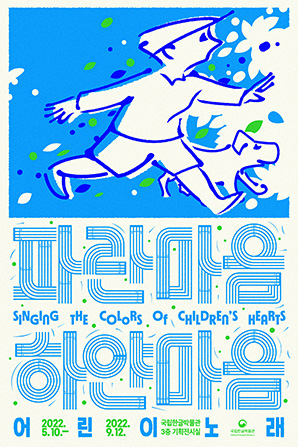Singing the Colors of Children’s Hearts
When it comes to children’s songs, we think of them as songs that are based on children's hearts. People cherish the songs that they grew up with in their childhood. The repetition of simple words in children’s songs helps the children develop verbal expressions and vocabulary. And the use of symbolic terms creates lively images and nurtures cheerful minds.
This exhibition, celebrating the 100th Children's Day, introduces the charm of the Korean language and writing through the lyrics of children’s songs and we hope you discover the child in you while enjoying it. The exhibition is composed of three parts and metaphorically reflects the children growing up playing in villages and in nature. You could appreciate the lyrics on the four seasons through symbolic elements in the first part. The second part leads you to experience the words and writings learned through songs with experiential elements.
In the last part, you could realize the times and value of the lyrics by looking back on the changes in the songs taught in school from the 1920s to the present day.
The songs that people remember do not age over time. The songs that we sang with the heart of children make us recall the memories of childhood. Those songs contain the past of adults and the present and future of children. This means that these songs belong not only to children but are shared by all generations, with only different colors and shades. Through the exhibition, we hope you find the lyrics that are still alive in your heart no matter how many years have passed.
Part 1: Spring Summer Fall Winter
In the world of children’s songs, there are no boundaries between children and animals and plants. Children talk to streams and snowflakes, and make friends with all the forest animals.
The lyrics of children’s songs capture the amazing moments of nature without using complicated words. In “Welcoming the Full Moon”, the moon dances in silky waves, and the tree in “Winter Tree” is personified as a naked figure. Colors that best match each season are used for warm spring, sultry summer, chilly autumn, and cold winter. Repeating short and simple words is quite enough for expressing the richness of nature and realizing natural order.
1-1. Blooming Spring
1-2. Splashing Summer
1-3. Breezy Fall
1-4. Snowy Winter
Part 2: Let's Get Together and Go Around the Neighborhood
As a child, playing with friends in the neighborhood was one of the main daily routines. Since children's song lyrics are written based on kids’ experiences, they also contain the contents of games through which kids learn Korean and communicate with friends while playing. This part of the exhibition presents two types of songs: “movement play songs” that kids sing moving their bodies in different ways and “word play songs” that they sing for the sake of having fun with words. The lyrics of “movement play songs” usually involve situations where kids are with their friends. So, they consist of sentences making suggestions or orders to each other, which describe the rules, methods, or order of the game. In “word play songs,” different types of word games are used and continuous and repetitive expressions such as one, two, and three often appear.
2-1. Movement Play
2-2. Word Play
Part 3: Happy Living
Children who used to play in villages and in nature grow up to experience a new society through the space of school as they become elementary school students. This last part of the exhibition designed as a classroom holds metaphors about the process of growing up.Here, we wish to reflect on the past, present, and future of children's songs. They went through three periods, and we will introduce the changes made in each period. In the 1920s, they became ample both in quality and quantity, with lyrics being produced that symbolized imaginary stories and the colonized fatherland. After Korea's liberation in 1945, energetic and constructive lyrics were compiled into textbooks to inspire patriotism and hope for a new era. In addition, bright and healing lyrics were also spread through broadcasting. Later, writing children's songs has shrunk at times due to commercialization and the popularity of popular songs. However, starting with the MBC Children’s Song Festival in 1983, it has adapted to the circumstances of the times with repeated ups and downs.
3-1. To the Children who Have Lost Their Country
3-2. The Children of a New Nation
3-3. Singing Is Fun




















